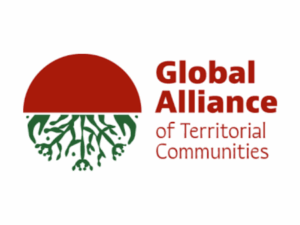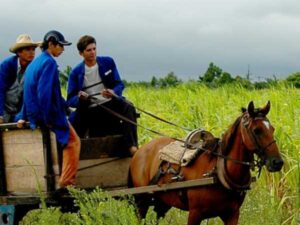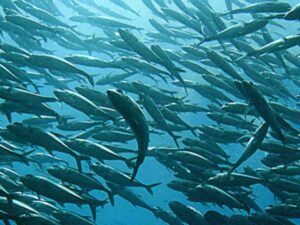Canopy aims to protect the world’s forests, species, and climate, and to help advance frontline communities’ rights.
Nicole Rycroft of Canopy spoke with Ambika Samarthya-Howard on July 29, 2025. Click here to read the full conversation with insights highlighted.
Ambika Samarthya-Howard: Can you start by introducing yourself and sharing a bit about the history of Canopy and your approach?
Nicole Rycroft: My name is Nicole Rycroft, and I founded Canopy in 1999 with the conviction that we were too smart to mow down vibrant forest ecosystems– trees that are only 1,000 years old, or 400 years old, forests that have been homes to traditional communities and Indigenous communities for millennia– just to make everyday commodities like paper, packaging, t-shirts, and the myriad of other products for which forests are mowed down purely for their cellulose.
I felt that we had to be smarter than this. There has to be another way. Canopy’s mission and mandate has always been to systematically alleviate the pressure on all forest ecosystems so they can be conserved at the scale that’s ecologically necessary for biodiversity and for having a stable climate, and that’s equitable from a human rights perspective, as well.
These forests are home to millions and millions of Indigenous and traditional peoples around the world. Those communities’ rights are generally swept aside when forests, be it in Canada, the US, Indonesia, Brazil, have been awarded as tenures or logging concessions and made available for logging, as well as for conversion into plantations. That’s always been at the core of our work. Our mission and mandate is to protect our forests, climate, and biodiversity, and to help support Frontline community rights.
Ambika Samarthya-Howard: I’ve heard a lot of people ask for transformation of supply chains, but very few people have anything to say about what’s working or what’s been successful in supply chain transformation. I’d love to know what you’ve tried that has landed, or that’s making real change in that area.
Nicole Rycroft: Our work is all about supply chains. In the early days, I was likely just shy of getting a restraining order from some of these companies. Back in the late ’90s and early 2000s, CSR [corporate social responsibility] was essentially doing a fundraiser for the local boys’ football club, and if you were super progressive, doing it for the girls’ football club as well. It wasn’t about taking on the question of: What’s the core business impact of my operations?
That was the context when we started. There’s a spectrum of tactics that the conservation movement, or the social justice movement, uses readily. There are organizations that we affectionately refer to as “rank and spank” organizations [that rely on performance management through punishment and reward], and there are stick organizations [that focus on making change stick]. Canopy is very consciously positioned as a carrot organization [as we focus on positive reinforcement]. We’re a pointy carrot organization, but our work is grounded in collective action.
We recognize that no single company can transform a supply chain by itself. You have to create pre-competitive spaces where you can bring brands, producers, and innovators that would otherwise be fiercely competitive together to achieve both their business goals and tackle shared environmental challenges. That’s a place where Canopy has done good, strong work in unusual ways. We focus on collective action, rather than just collaboration.
There are a lot of initiatives about collaboration, and sometimes it becomes collaboration for collaboration’s sake. Our work has always been geared towards clarity about what we’re working towards, and time-lined commitments and actions along that path. When you’re building those kinds of initiatives, you have to identify the early changemakers.
Way back when our work started, and no one was talking about sustainability, we chose to work with the book publishing sector because it’s about ideas, it’s full of articulate, outspoken people and writers, and it’s about paper. We partnered with Penguin Random House and Scholastic, and did work on the Harry Potter series.
Ambika Samarthya-Howard: How did you get into the book publishing space? How did you make those partnerships, and how did it work out?
Nicole Rycroft: For us, partnership starts with a formal commitment, a policy commitment. That policy generally has a number of elements to it, but it has three main pillars for us. One is a commitment to not source from the world’s ancient and endangered forests or from socially controversial forest ecosystems. There’s a timeline to the commitment. Generally, it’s over a three-year period.
The second one is leaning in to help enable the scaling of what we call next-gen solutions. There’s no need for us to be reliant on forests for the fiber for Amazon boxes, cereal boxes, books, textiles, viscose textiles, or rayon textiles. All of those materials are made from cellulose, and you can find cellulose in any available plant material.
Consider industrial food waste and textiles. There are hundreds of millions of tons of agricultural residues, straw left over after the food grain harvest every year, that are burnt in the field by farmers, just so they can get it off the field. There are an estimated 150 people who die every day in India because of the burning of straw on fields, from the stubble burn and the associated pollution’s impacts on human health. We are also now voracious in our appetite for textiles. The textile recycling system is very nascent, so most textiles end up in landfills, degrading into methane. All of these things that we currently think of as waste are rich in cellulose and can be fed back into the supply chain.
We ask brands or publishers to commit to leaning in to help scale this transition or accelerate this transition to more circular production that utilizes such alternatives.
The third layer of commitment is around advocating for change. It’s clean production, smart design to foster reduced consumption, and advocating for change. That’s the start of our work with a publisher, or with brands like H&M, or Target.
Back in the publishing days, there were no environmental papers available. Occasionally, they’d have a very strong environmentally-conscious author, so they’d have to do a specific run of paper, made of 100% recycled content, but because it was a special run, it always cost five arms and six legs. It was always prohibitively priced. The publishers would then say, Environmental papers are too expensive. It was a question of how we can create enough collective momentum to achieve an economy of scale in the production system.
We started working to build a collective, a broader movement of publishers, both large and small, to make these commitments and engage their printers and paper suppliers. We wanted this to happen with the largest print run. Back in 2000, when we started this work, the largest print runs were the Bible and Harry Potter. Harry Potter seemed like it was going to be more fun to work with. Our goal was to leverage the commercial volumes that were associated with that series.
Canopy worked with the Canadian publisher of the Harry Potter series to have the fifth book in the series, Harry Potter and the Order of the Phoenix, printed on environmental paper. We essentially speed-dated them with a number of progressive paper mills to see which of them could match the performance spec that was required, plus the environmental performance and the price point. Rolland papers in Canada stepped forward and met that spec. Harry Potter and the Order of the Phoenix in Canada was the only edition of the book when it was released.
I don’t know if you remember the cultural phenomenon of Harry Potter book releases. And here was the only global edition, printed on environmental paper. J.K. Rowling wrote a quote specifically for the Canadian edition. She was very wary of interviews, so the fact that she’d given a personalized quote for our edition really caught everyone’s attention. Then, Harry Potter 6 and 7 followed the two years after.
The work that we’d done with the Canadian publisher moved to global publishing. By the 7th and final book in the series, there were 24 Harry Potter editions globally that were printed on environmental paper, including the US edition, which was massive– 12 million copies. It was a hefty page count. Because there was such an economy of scale with that book and such a large run, we were able to leverage other publishers to access that environmental paper.
There were 40 types of environmental paper that were either 100% recycled or a combination of FSC Virgin Wood Fiber and post-consumer recycled that were developed specifically for the Harry Potter series. Many of those are still available today.
Ambika Samarthya-Howard: How did you connect with the right people to pull that off? Often, the people that you have access to are not the people who make the decisions. How did that work?
Nicole Rycroft: It pays to be shameless when you’re an environmental troublemaker. I was on the phone, leaving messages and trying to sweet-talk the publishers. Some decisions sit at the publisher’s level and some at the CEO’s level. My initial point of contact was to bring the publisher on as a champion and then help build the case for the CEO with them.
Raincoast Books was the Canadian publisher of Harry Potter. At the time, they had a phenomenal publisher and a phenomenal CEO who believed in this and who were willing to step forward and take the risk. We sent an FSC-certified Quidditch stick to J.K. Rowling, and she was immediately supportive. Knowing that there was that level of support from the author herself was quite helpful.
Ambika Samarthya-Howard: I’m also curious about the supply. Did you have to find where you could get these 40 papers, or did you have to create funding for those 40 papers?
Nicole Rycroft: In terms of finding the paper, we had a lay of the land of which paper suppliers were at least dabbling in environmental papers. Then, the publisher had suppliers with whom they already had strong relationships. The first couple of papers were brought in via the angle of, These paper mills have already shown their ability to produce publication-quality papers with high recycled content. Let’s go to them and see if they can meet the spec.
Once we moved on from the Canadian edition of Harry Potter, we were working with the publishers as they leaned in to engage their mainstream and conventional mills to provide them with environmental options.
Ambika Samarthya-Howard: When did this happen in relation to the Audacious Project?
Nicole Rycroft: This was way before Audacious. Harry Potter and the Order of the Phoenix was 2003, then the sixth book in the series was 2005, and the last one was 2007. We used the work we did with the book publishing industry as a blueprint, then we replicated it across different sectors. We worked with the magazine publishing sector, with newspaper publishing, with commercial print, and then we started our work in the fashion industry in 2013.
We started in the realm of pulp being put into paper and moved into pulp being put into the third-largest fiber type used in textiles and fashion. The technical term for it within the industry is “man-made cellulosic fibers,” but when you look at a clothing label, it’ll commonly show up as viscose, rayon, modal, or lyocell.
Ambika Samarthya-Howard: Was that material how you were able to move from printing to textiles?
Nicole Rycroft: The materials made from tree fiber and the supply chain are different. The viscose supply chain is opaque. Fashion is different in the way that it’s structured. Fiber is fiber. Pulp is pulp trees. However, the impact on forest ecosystems and the impact on frontline communities is the same.
Ultimately, you have similar market dynamics. You have this supply and demand dynamic that is being used as a smokescreen for unsustainable practices happening on the ground. When we started to work with the fashion industry, we recognized that there was a pinch point within the supply chain at the rayon producer or the viscose producer level. We worked with brands. To start, it was about orienting them to the impact of this rayon and viscose supply chain, because many of them had no idea that their textiles were coming from high-carbon, high-biodiversity-value forests that were often also Indigenous lands. Then it was about helping them develop a building strategy and see their own role in helping to drive change.
The CanopyStyle initiative to transform the viscose supply chain is the fastest-moving environmental initiative within the fashion sector. Ten years ago, viscose production was very opaque. There was no guarantee that any viscose textile was not coming from a high-carbon, high-biodiversity-value forest. Now, we have 550 brands formally on board. They represent about a trillion dollars in annual revenues. Those range from the Louis Vuittons and the Stella McCartneys of the world to the Targets, the Walmarts, the H&Ms, the Inter-Texases, and everybody in between. As a result of that very consistent message from this collective of brands working together, we now have about 97% of global viscose producers on board with a commitment to stop sourcing from endangered forests.
Of course, commitment and action often have a time lag. We’ve now got 71% of producers, and they produce around 54% of the global volume of viscose textiles with green shirts in an annual rating we do. They’re at low risk of sourcing from a high-carbon, high-biodiversity-value forest.
We’re also seeing viscose producers lean into integrating recycled textiles and recycled bamboo furniture into their operations as a way to start diversifying their fiber basket and become less reliant on trees.
Ambika Samarthya-Howard: Climate and business often have a very tense dynamic. How have you managed these points of tension?
NicoleRycroft: My view is that creative tension is never a bad thing. If you’ve got authentic partnerships, then of course tensions are going to arise. It’s more about the spirit and intent with which you lean into tension because tension is often fertile ground for innovation and breakthrough moments.
Of course, when a brand is unpacking where its supplier is coming from, it can unveil risk, or lead to questions around a supplier who might be providing a well-priced or a good-quality product, or whom someone has worked with for years. Those questions can lead to difficult decisions.
We’ve never been about shame and blame. It’s about how we can pragmatically deal with where we’re at ecologically and where we need to be. We roll up our sleeves and co-develop what those solutions look like. As long as we have a partner who’s wooing the other side, then we generally find there’s a way through.
There was a big social shift in terms of awareness of climate change between 1999 to 2015 or so. What we’re seeing since then is that taking action on climate-related issues, and supply chain issues in particular, is no longer just a nice-to-have initiative for a brand. It’s a foundational strategy for resilience because there’s so much climate-induced volatility and so many biodiversity disruptions coming into supply chains now.
Big, global brands are becoming cognizant that unless we accelerate this transition away from the linear “take, make, waste” production system, and away from supply chains that are contributing to the stress on our climate and on biodiversity, then it’s going to be very challenging to have a viable business model in another five, ten, or twenty years.
Ambika Samarthya-Howard: What have you learned from scaling with the Audacious Project? Where are you now in the process, and where are you going?
Nicole Rycroft: The Audacious investment has been a game changer for us. It’s given us the runway to not just dream big, but to be able to deliver at scale. We have grown a lot. We received our Audacious Project grant in 2023, and we pushed it to last until 2030, which is how a lot of ecological targets are timed.
As you can imagine, supply chain transformation doesn’t happen overnight. We were a very modestly resourced organization prior to Audacious. We knew that, considering our ability to absorb that kind of support and the intensity of the work of transforming supply chains in and of itself, we weren’t going to be able to achieve what we’re setting out to achieve in two years.
The Audacious grant has enabled us to ramp up our capacity and our team. Simply being recognized by Audacious, and having the bench strength that we now have, has gotten us in the door with some big corporate conglomerates that had previously dismissed us as too small. They’d say things like, You do really interesting work, and you’ve got an impressive track record, but we’re who we are, and you guys are small, and we’ll eat you whole. Now, they’re talking to us. Audacious has taken us into new markets.
We’ve been working in China through our work in the fashion industry for 10 years, but with Audacious, we’ve been able to bring more capacity to that work. In the last three months alone we’ve had four big Chinese viscose producers launch their own in-house, next-gen production lines. They’re starting machines right alongside their current wood machines with commitments or timelines to scale that production up to commercial scale by 2027.
Over the next 18 months, we’re working in India. We’re doing a lot of work there at the moment to help establish India as an early next-gen production hub. It’s similar to the work we’re now doing in China, North America, and Europe. It’s helped us move into new sectors, as well.
It’s great to have the market pull through, that’s foundational, and it’s great to be working with the pipeline of game-changing innovators and conventional producers. Pulp infrastructure, just like energy infrastructure, is incredibly capital-intensive. We’ve started doing a bunch of work in mobilizing the scale of investment, which we estimate will be about $80 billion over the next decade, into this supply transformation.
You also need different kinds of capital for development in the Global North than you do in the Global South. We’re working to establish a private equity vehicle that is focused on solutions in the Global North, and we’re also working with the UN and multilateral banks to establish a blended finance platform for India as a prototype. Audacious has enabled us to expand into some of those other areas within the broader ecosystem that are needed to transform supply chains at scale.
Ambika Samarthya-Howard: How are you incorporating joy into your strategy, and what is the impact?
Nicole Rycroft: It stems from personal philosophy. No one wants to join the army of the glum. This work can be heavy. I’ve found that when you lead with possibility, you can unlock creativity and connection. If you approach things with joy, if you seem as though you’re fun to work with, that in itself has a magnetic factor and force to it. I would say the joy in our work is about celebrating life on earth.
Why would we not bring that into the core of our work? It helps build movements. It reminds us of why we’re doing this work. Having fun and saving the planet together is a pretty powerful motivator for people to do things that are perhaps a little bit unusual in their work, be it within government, in investment firms, in brands, or on the production side of things.
Ambika Samarthya-Howard: How do you actualize that?
Nicole Rycroft: We actualize it in different ways. There was one brand, a very high-end designer, who was so on board, and so creative. However, they could not finalize their policy for an extended period. I turned up to one of our meetings with a bottle of scotch and said, We’re either going to drown our sorrows or celebrate the policy. They loved it.
We have given very specific 007 missions to some of our brand partners with 007-style briefs. We like to mix it up, make it a little bit quirky and, hopefully, fun.
Ambika Samarthya-Howard: Thank you so much for your time and your insights.
Click here to read the full conversation with insights highlighted.
Ambika Samarthya-Howard (she/her) is the Solutions Journalism Network’s Chief Innovation Officer: She leads on innovation and technology, leverages communication platforms for the network strategy and creates cool content. She has an MFA from Columbia’s Film School and has been creating, teaching and writing at the intersection of storytelling and social good for two decades. She has produced content for Current TV, UNICEF, Havas, Praekelt.org, UNICEF, UNFPA, Save the Children, FCDO, Global Integrity and Prism.
* This interview has been edited and condensed.







